No products in the cart.
No products in the cart.
No products in the cart.
No products in the cart.
Home » Neurological Recovery Blog » Cerebral Palsy » Aquatic Therapy for Cerebral Palsy: A Fun, Motivating Form of Rehabilitation
Last updated on May 5, 2021
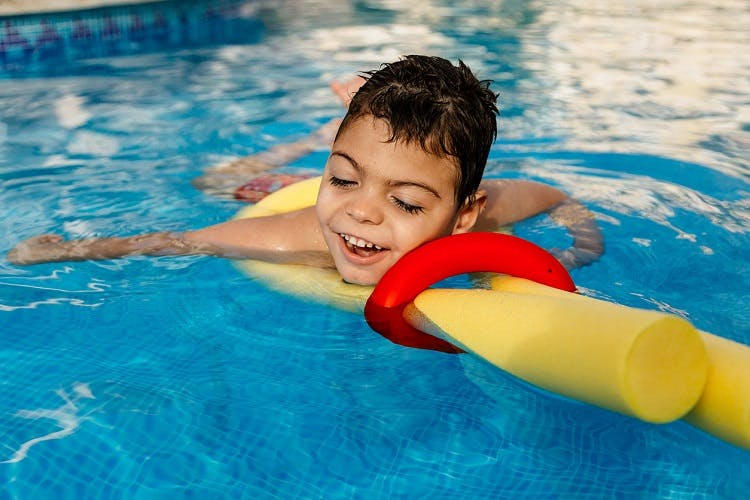
Can aquatic therapy help individuals with cerebral palsy improve their mobility?
Aquatic therapy is a type of rehabilitative therapy that takes place in a pool. It makes it fun and motivating to participate in physical activity.
Additionally, water has several unique properties that may help individuals with cerebral palsy improve their functional mobility.
This article will go over the various techniques involved in aquatic therapy and how they can benefit individuals with cerebral palsy.
Everyone experiences cerebral palsy differently. Therefore, the methods used in aquatic therapy will vary depending on the individual’s specific needs.
Aquatic therapy for cerebral palsy can involve various water-based exercises, including:
Floatation devices (vests, barbells, resistance bands, noodles, boards) are used to help keep individuals’ heads out of the water. They ensure extra safety so that individuals can focus on their movements.
Moreover, the exercises are guided by a physical or occupational therapist, so parents can feel assured that their children will be safe.
In the following section, we’ll discuss the benefits of aquatic therapy and how it can help individuals with cerebral palsy improve their mobility.
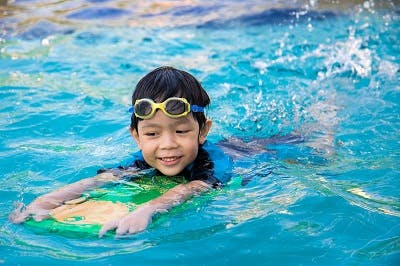
Aquatic therapy can help individuals with CP develop a wide range of motor functions. Practicing these skills in water may help ease the transition onto land.
Benefits of aquatic therapy for cerebral palsy include improved:
Additionally, aquatic therapy can help boost one’s confidence. Because individuals may be able to move better in water than on land, they often feel more hopeful that improvements are possible. This will motivate them to move around and perform more repetitions of challenging movements to activate the brain’s neuroplasticity.
Up next, we’ll discuss why practicing exercises in water can help provide therapeutic relief and promote motor improvements.
There are 4 unique properties of water that make aquatic therapy ideal for individuals with cerebral palsy.
Below, we’ll discuss these properties and how they can help individuals with cerebral palsy improve their motor skills:
Participating in aquatic therapy allows individuals with cerebral palsy to take advantage of buoyancy. Buoyancy is what decreases the effect of gravity and keeps individuals afloat when submerged in water.
It makes you feel weightless and relieves pressure off the joints, which makes it easier for individuals to focus on their movements. It may even allow you to stand when you would be unable to do so on land due to lower body weakness.
Another beneficial property of water is viscosity. Viscosity is how much resistance a fluid has. For example, water is less viscous than honey.
Viscosity is what makes it challenging to walk quickly underwater. There’s much more resistance when walking in water than walking on land.
Because individuals have to push against the resistance of water to move, practicing exercises in a pool can help develop strength.
Hydrostatic pressure refers to the pressure of water on the body from all different directions.
Consistent pressure on the body helps decrease swelling and improve circulation. This can be especially helpful for individuals with cerebral palsy whose motor impairments make it challenging to get enough physical activity throughout the day or who are unable to move certain areas of the body.
Often, aquatic therapy takes place in a heated pool, which provides additional therapeutic benefits for individuals with cerebral palsy.
Heat helps increase the elasticity of soft tissue, relaxes the muscles, and reduces pain.
The following section will discuss how to maximize the effects of aquatic therapy.
As with all forms of rehabilitative therapies for cerebral palsy, aquatic therapy focuses on promoting neuroplasticity. Neuroplasticity is the brain’s ability to make adaptive changes.
The brain damage that causes cerebral palsy does not worsen over time, so by activating neuroplasticity through repetitive stimulation, the brain may be able to reorganize itself to strengthen and improve movement patterns.
The most effective way to replace a poor habit is to practice a new, challenging task. Being submerged in the water adds a completely new challenge to walking, so it fires a whole new set of neural pathways in the brain than walking on land. This could result in a better gait pattern, even when walking outside of the pool. The more you repeat the action, the stronger the neural pathways for it become.
Additionally, aquatic therapy serves as a fun form of physical activity. Finding what keeps your child motivated is essential for keeping them engaged and performing the repetitions they need to improve.
Aquatic therapy for cerebral palsy is a popular alternative to traditional exercises on land.
The change of environment helps keeps kids engaged and physically active. Additionally, practicing exercises in water allows for less pressure on the joints, develops strength, and improves circulation.
We hope this article helped you understand how aquatic therapy may help individuals with CP improve their motor functions.
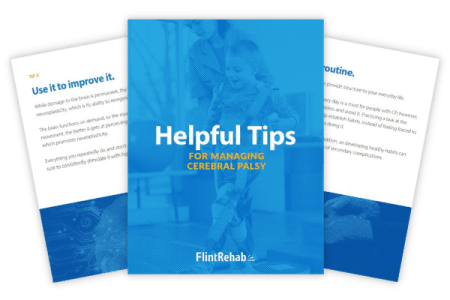
Get our free 19-page PDF full of helpful tips for cerebral palsy by signing up below! If you liked this article, you’ll LOVE our free ebook.
When you sign up, you’ll also receive our popular emails that share more tips for life with cerebral palsy — you can opt out anytime.
We will never sell your email address, and we never spam. That we promise.
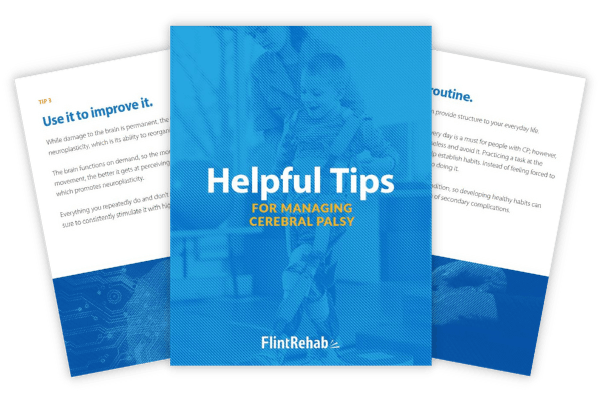

At Flint Rehab, we understand that doing physical therapy at home can become tedious and repetitive. But when repetition is critical to recovery, it’s important to stick with a repetitive regimen. But that doesn’t mean it has to be boring.
Flint Rehab is the leading manufacturer of motion-sensing, gamified rehabilitation devices. Our bestselling recovery tool, FitMi, transforms full-body rehab exercises into an interactive experience.
See what individuals with CP are saying about FitMi:
“The FitMi and MusicGlove have done wonders for my son with hemiparesis from cerebral palsy and stroke. It motivates him to do his exercises. It does not seem like therapy for him since it is fun. FitMi monitors his progress so it is a great reinforcement for him. Music is a motivator for him. He has been using it on his arm and we will try the leg exercises soon.”
-Manning
While FitMi is a recovery tool for the full-body, our other device, MusicGlove, helps target the hand to improve fine motor skills and dexterity.
See what others have said about MusicGlove:
“My granddaughter has right-side hemiplegia from Cerebral Palsy / stroke at birth. She states that this is a great product for anyone who has issues with the use of their hand(s), and that is has helped her tremendously. She also finds the music quite catchy (surprisingly!). Our occupational therapist has been impressed as well. I can say that it has arguably been the best tool of all our therapy resources.”
-Jenni
Together, FitMi and MusicGlove make a powerful home therapy regimen for individuals with cerebral palsy. Best of all, you can save money when you bundle them together.
To learn more, click the button below:
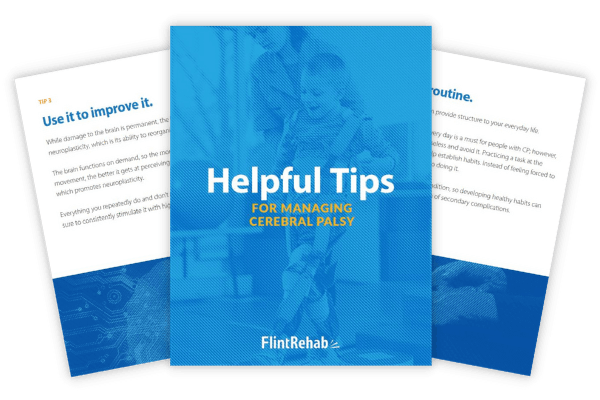
Do you have these 19 pages of helpful tips for CP?
Get a free copy of our ebook Helpful Tips for Managing Cerebral Palsy. Click here to get instant access.
Grab a free rehab exercise ebook!
Sign up to receive a free PDF ebook with recovery exercises for stroke, traumatic brain injury, or spinal cord injury below: